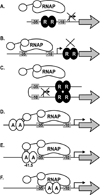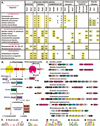Comparative genomic reconstruction of transcriptional regulatory networks in bacteria
- PMID: 17636889
- PMCID: PMC2643304
- DOI: 10.1021/cr068309+
Comparative genomic reconstruction of transcriptional regulatory networks in bacteria
Figures







References
-
- Baumberg S. Prokaryotic Gene Expression. Oxford: Oxford University Press; 1999.
-
- Lloyd G, Landini P, Busby S. Essays Biochem. 2001;37:17. - PubMed
-
- Gollnick P, Babitzke P. Biochim. Biophys. Acta. 2002;1577:240. - PubMed
-
- Hodgson DA. Signals, Switches, Regulons, and Cascades. Cambridge: Cambridge University Press; 2002.
Publication types
MeSH terms
Grants and funding
LinkOut - more resources
Full Text Sources
Other Literature Sources

